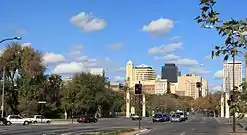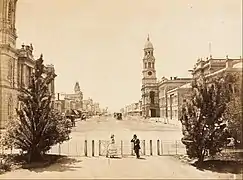King William Street, Adelaide
King William Street is the part of a major arterial road that traverses the CBD and centre of Adelaide, continuing as King William Road to the north of North Terrace and south of South Terrace. At approximately 40 metres (130 ft) wide, King William Street is the widest main street of all the Australian State capital cities. Named after King William IV in 1837, it is historically considered one of Adelaide's high streets, for its focal point of businesses, shops and other prominent establishments. The Glenelg tram line runs along the middle of the street through the city centre.


History
It was named by the Street Naming Committee on 23 May 1837 after King William IV, the then reigning monarch, who died within a month.[1] It is historically considered one of Adelaide's high streets, for its focal point of businesses, shops and other prominent establishments.
In August 1977, the first bus lane in Adelaide opened along King William Street from Victoria Square to North Terrace.[2]
Description
The name King William is applied several times to the continuous stretch of road that begins in the inner southern suburbs and terminates in North Adelaide. Where it runs through the Adelaide city centre from South Terrace to North Terrace, it is named "King William Street"; elsewhere it is named "King William Road".[3]
It starts in the south as King William Road, at the north edge of Heywood Park in Unley Park, and runs through Hyde Park and Unley to Greenhill Road.[3] The road through the south parklands is named Peacock Road after Caleb Peacock who was Mayor of Adelaide from 1875 to 1877.[4] Through the Adelaide city centre it is King William Street and continues north from North Terrace as King William Road to Brougham Place, North Adelaide.[3]
At approximately 40 metres (130 ft) wide, King William Street is the widest main street of all the Australian State capital cities.
The road continues north to National Highway 1 as O'Connell Street, but the name King William is not again used. The northern section called King William Road (connecting the Adelaide city centre with North Adelaide) passes several of Adelaide's landmarks, including Government House, Elder Park, the Adelaide Festival Centre, Adelaide Oval and St Peter's Cathedral. The section from North Terrace over the Adelaide Bridge to Pennington Terrace was named King William Road at the opening of the bridge in 1877.[5]
.jpg.webp)
Until the 1960s, trams used King William Street as a major backbone of the network, with a grand union junction at North Terrace and only one pair of tracks missing between Grenfell and Currie Streets.[6] When most of the tram lines were dismantled in the 1950s, only the Glenelg tram line remained, and it used King William Street between South Terrace and its terminus at Victoria Square.[7]
In 2007, the tram line was extended to run the full length of King William Street again, turning left onto North Terrace and terminating at Adelaide railway station, later extended westwards via Port Road to the Adelaide Entertainment Centre. In 2018, another expansion of the tram routes replaced the turn at the intersection of North Terrace and King William Street with a junction, and a short spur to a stop outside the Adelaide Festival Centre as well as an eastward extension along North Terrace to the Adelaide Botanic Garden. Tracks go in all four directions, but not all turning movements are supported.[8]
Junctions and street name changes
Between North Terrace and South Terrace, all east-west roads change their names as they cross King William Street. It is said this is because no one was allowed to "cross the path of a monarch".[1] Travelling south from North Terrace, the street pairs are:[9]
In popular culture
King William Road was referenced in the John Schumann song "Hyde Park Calling (King William Road Scene 1)" on the 1993 album True Believers.
Gallery
_opp._Beehive_Corner%252C_Cnr_King_William_%2526_Rundle_Streets%252C_1866.jpg.webp) The street (running left to right), 1867
The street (running left to right), 1867 View from Victoria Square, 1870s
View from Victoria Square, 1870s C. 1869-1889. Town Hall on left, Post Office on right.
C. 1869-1889. Town Hall on left, Post Office on right..jpg.webp) Sometime between 1869 and 1889.
Sometime between 1869 and 1889. The street, 1923
The street, 1923 King William Street, looking north from Victoria Square, February 2009.
King William Street, looking north from Victoria Square, February 2009..jpg.webp) View south from Rundle Mall, 2004
View south from Rundle Mall, 2004 King William Street looking south, December 2010
King William Street looking south, December 2010 The intersection from King William Street, looking east towards Rundle Mall, 2013.
The intersection from King William Street, looking east towards Rundle Mall, 2013. King William Street between North Terrace and Currie Street, looking south-west, November 2006.
King William Street between North Terrace and Currie Street, looking south-west, November 2006. View south from the Festival Centre, before the Festival Centre tram stop was built.
View south from the Festival Centre, before the Festival Centre tram stop was built. King William Road, North Adelaide, from the Adelaide Oval, looking south over the River Torrens towards North Terrace, King William Street and the Adelaide city centre, May 2009.
King William Road, North Adelaide, from the Adelaide Oval, looking south over the River Torrens towards North Terrace, King William Street and the Adelaide city centre, May 2009..jpg.webp) King William Street, looking north towards St Peter's Cathedral
King William Street, looking north towards St Peter's Cathedral
See also
![]() Australian Roads portal
Australian Roads portal
References
- "History of Adelaide through street names – Street Names". www.historysouthaustralia.net. Archived from the original on 27 August 2008. Retrieved 11 September 2008.
- Bus Only Lane in King William Street Among Ourselves issue 177 October 1977 page 9
- 2003 Adelaide Street Directory, 41st Edition. UBD (A Division of Universal Press Pty Ltd). 2003. ISBN 0-7319-1441-4.
- "Nomenclature of the Streets of Adelaide and North Adelaide" (PDF) – via State Library of South Australia.
- "OPENING OF THE ADELAIDE BRIDGE". South Australian Register. Adelaide. 17 May 1877. p. 3 Supplement: Supplement to the South Australian Register. Retrieved 9 December 2014 – via National Library of Australia.
- "Trolley Wire" (PDF). South Pacific Pacific Electric Railway Co-operative Society Limited. August 1992. p. 5. Retrieved 19 January 2018.
- Prosser, Candice (1 December 2017). "Curious Adelaide: Why was Adelaide's tram network ripped up in the 1950s?". ABC News. Australian Broadcasting Corporation. Retrieved 31 July 2019.
- Gailberger, Jade (22 November 2017). "Government tries explaining why Adelaide trams could turn right 100 years ago — but not now". The Advertiser. Retrieved 19 January 2018.
- Map of the Adelaide city centre, North Adelaide and the Adelaide Parklands.